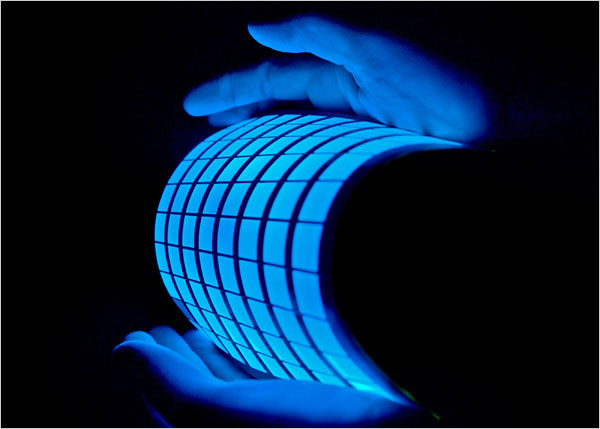
With their minuscule energy consumption and 20-year life expectancy, LED light bulbs have grabbed the consumer’s imagination.
But an even newer technology is intriguing the world’s lighting designers: OLEDs, or organic light-emitting diodes, create long-lasting, highly efficient illumination in a wide range of colors, just like their inorganic LED cousins. But unlike LEDs, which provide points of light like standard incandescent bulbs, OLEDs create uniform, diffuse light across ultrathin sheets of material that eventually can even be made to be flexible.
Ingo Maurer, who has designed chandeliers of shattered plates and light bulbs with bird wings, is using 10 OLED panels in a table lamp in the shape of a tree. The first of its kind, it sells for about $10,000.
He is thinking of other uses. “If you make a wall divider with OLED panels, it can be extremely decorative. I would combine it with point light sources,” he said.
Other designers have thought about putting them in ceiling tiles or in Venetian blinds, so that after dusk a room looks as if sunshine is still streaming in.
Today, OLEDs are used in a few cellphones, like the Impression from Samsung, and for small, expensive, ultrathin TVs from Sony and soon from LG. (Sony’s only OLED television, with an 11-inch screen, costs $2,500.) OLED displays produce a high-resolution picture with wider viewing angles than LCD screens.
In 2008, seven million of the one billion cellphones sold worldwide used OLED screens, according to Jennifer Colegrove, a DisplaySearch analyst. She predicts that next year, that number will jump more than sevenfold, to 50 million phones.
But OLED lighting may be the most promising market. Within a year, manufacturers expect to sell the first OLED sheets that one day will illuminate large residential and commercial spaces. Eventually they will be as energy efficient and long-lasting as LED bulbs, they say.
Because of the diffuse, even light that OLEDs emit, they will supplement, rather than replace, other energy-efficient technologies, like LED, compact fluorescent and advanced incandescent bulbs that create light from a single small point.
Its use may be limited at first, designers say, and not just because of its high price. “OLED lighting is even and monotonous,” said Mr. Maurer, a lighting designer with studios in Munich and New York. “It has no drama; it misses the spiritual side.”
“OLED lighting is almost unreal,” said Hannes Koch, a founder of rAndom International in London, a product design firm. “It will change the quality of light in public and private spaces.”
Mr. Koch’s firm was recently commissioned by Philips to create a prototype wall of OLED light, whose sections light up in response to movement.
Because OLED panels could be flexible, lighting companies are imagining sheets of lighting material wrapped around columns. (General Electric created an OLED-wrapped Christmas tree as an experiment.) OLED can also be incorporated into glass windows; nearly transparent when the light is off, the glass would become opaque when illuminated.
Because OLED panels are just 0.07 of an inch thick and give off virtually no heat when lighted, one day architects will no longer need to leave space in ceilings for deep lighting fixtures, just as homeowners do not need a deep armoire for their television now that flat-panel TVs are common.
The new technology is being developed by major lighting companies like G.E., Konica Minolta, Osram Sylvania, Philips and Universal Display.
“We’re putting significant financial resources into OLED development,” said Dieter Bertram, general manager for Philips’s OLED lighting group. Philips recently stepped up its investment in this area with the world’s first production line for OLED lighting, in Aachen, Germany.
Universal Display, a company started 15 years ago that develops and licenses OLED technologies, has received about $10 million in government grants over the last five years for OLED development, said Joel Chaddock, a technical project manager for solid state lighting in the Energy Department.
Armstrong World Industries and the Energy Department collaborated with Universal Display to develop thin ceiling tiles that are cool to the touch while producing pleasing white light that can be dimmed like standard incandescent bulbs. With a recently awarded $1.65 million government contract, Universal is now creating sheetlike undercabinet lights.
“The government’s role is to keep the focus on energy efficiency,” Mr. Chaddock said. “Without government input, people would settle for the neater aspects of the technology.”
G.E. is developing a roll-to-roll manufacturing process, similar to the way photo film and food packaging are created; it expects to offer OLED lighting sheets as early as the end of next year.
“We think that a flexible product is the way to go,” said Anil Duggal, head of G.E.’s 30-person OLED development team. OLED is one of G.E.’s top research priorities; the company is spending more than half its research and development budget for lighting on OLED.
Exploiting the flexible nature of OLED technology, Universal Display has developed prototype displays for the United States military, including a pen with a built-in screen that can roll in and out of the barrel.
The company has also supplied the Air Force with a flexible, wearable tablet that includes GPS technology and video conferencing capabilities.
As production increases and the price inevitably drops, OLED will eventually find wider use, its proponents believe, in cars, homes and businesses.
“I want to get the price down to $6 for an OLED device that gives off the same amount of light as a standard 60-watt bulb,” said Mr. Duggal of G.E. “Then, we’ll be competitive.”
